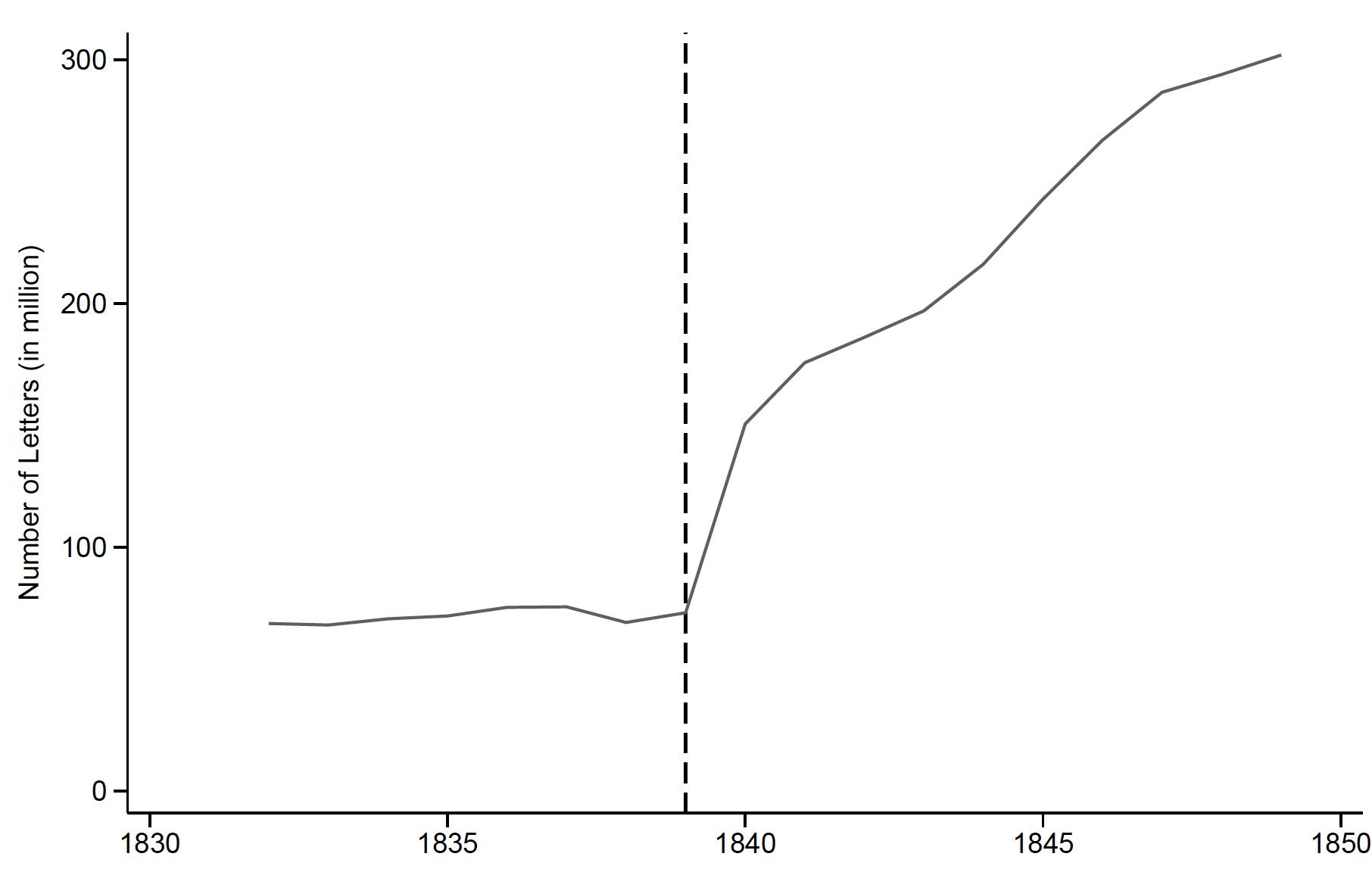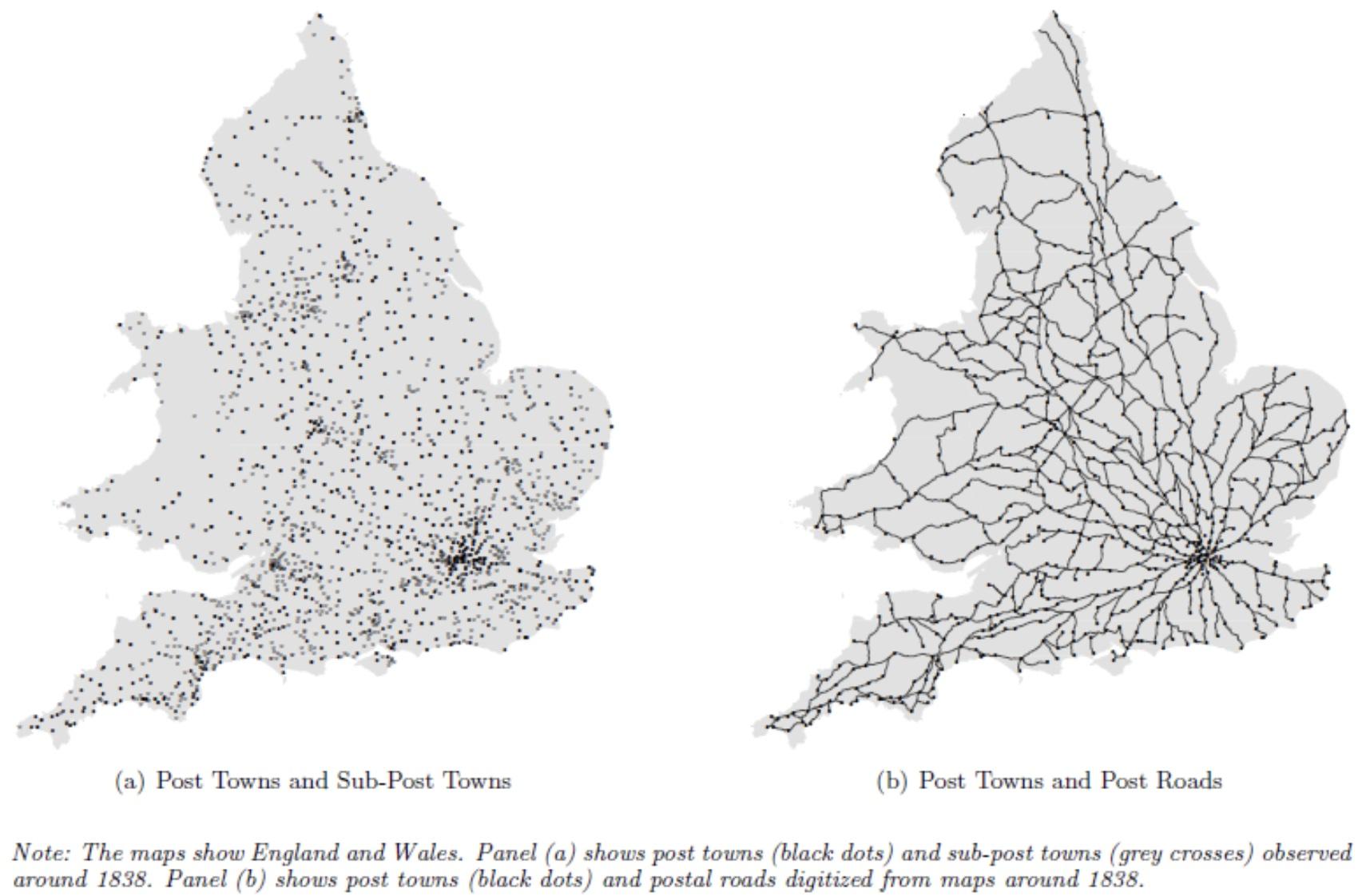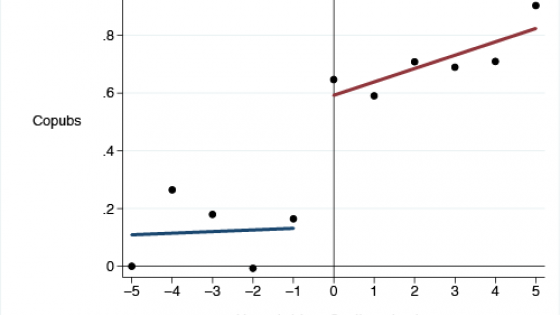Scientific and technological progress are fundamental drivers of long-run economic growth (Romer 1986, Lucas 1988). Not surprisingly, a great deal of research has aimed to understand the factors that facilitate science and technological development. One factor that has received substantial attention is the role of communication between scientists, engineers, and inventors. It seems natural that those working at the frontier of scientific and technical knowledge would benefit from exchanging information, discussing their ideas, and receiving advice and feedback on their work. Yet, only a limited number of empirical studies look at how much communication costs impede scientific and technological development and thus long-run economic growth.
A primary challenge to studying communication costs in modern environments is the vast array of communication methods available. When individuals can easily substitute between different communication channels, it is difficult to isolate the impact of changes in communication costs on outcomes.
Researchers have taken four general approaches to deal with this challenge. One approach infers the importance of communication without directly measuring communication costs. For example, Jaffe et al. (1993) looked at the geographic proximity of inventors that cited one another in patents to infer the importance of communication costs, which presumably are smaller over shorter distances.
A second approach has been to consider observed changes to trade costs (e.g. Agrawal et al. 2017 using highways, or Catalini et al. 2020 using airlines) that imply changes in communication costs.
A third focuses on narrow events and communities where changes in communication costs can be better isolated. Agrawal and Goldfarb (2008) study the impact of BITNET, an early precursor to the internet, on collaboration among university researchers.
A fourth approach involves examining historical settings, when there were far fewer methods for long-distance communication. Existing studies – such as Claudia Steinwender’s (2018) work on the introduction of the Atlantic telegraph cable on trade flows and Peter Koudij’s (2014) work on 18th-century financial markets – have shown how historical settings can be used to obtain better-identified evidence on the importance of communication. However, existing work in this vein has not yet examined the impact of communication costs on science or innovation.
In Hanlon et al. (2022), we draw on one of the most dramatic changes in communication technology in history, the introduction of the first modern postal system in Britain in 1840, to provide new evidence on the influence of communication costs on both science and technology development.
An 1839 Act of Parliament replaced Britain’s complex and expensive system of distance-based postage with a single low postage rate, the Uniform Penny Post, and the first adhesive postage stamp, the famous Penny Black. The result was an enormous and rapid increase in the number of letters sent (Figure 1).
Figure 1 Number of letters sent in Britain, before and after the Uniform Penny Post
Because the reform replaced a distance-based postage system with a single uniform rate, the reduction in communication costs varied across space. We exploit this as a natural experiment to examine the effects of communication costs on science and technology development.
The first step in our analysis is measuring the change in communication costs between locations in the UK. To develop this measure, we identify and geolocate 618 post towns in England and Wales and over 1,600 associated sub-post towns (left-hand panel of Figure 2). We also map out the postal road network connecting each post town (right-hand panel of Figure 2). Reconstructing the distance-based pricing scheme before the 1840 reform, we calculate the change in postage costs between any two post towns in the country due to the reform.
Figure 2 Post towns, sub-post towns, and post roads in the UK around 1838
To study the impact on science, we collect articles and citations from the leading academic journal of the era, the Philosophical Transactions of the Royal Society of London. We geolocate each author and cited scientist through a meticulous manual review of available biographical sources for each individual. Once geolocated, these data allow us to examine whether we see a relative increase in citations between pairs of scientists that experienced a larger relative reduction in bilateral communication costs following the reform. Our results clearly show increased scientific citations caused by lower communication costs. After the reform, the gradient with which citations declined with distance-based postage costs fell by around 70%.
To examine the impact on technology development, we use patent data, a standard data source for investigating innovation outcomes. Specifically, we look at whether patenting increased in locations that benefited more from the reform. To construct a location-level measure of the impact of the reform, we follow the market access approach of Donaldson and Hornbeck (2016) but applied it to communication costs to generate a letter market access measure. We show that patenting increased in locations that experienced more significant improvements in letter market access due to the reform.
Naturally, we have to be careful that the estimated effects were due to the postal reform rather than to other changes occurring in Britain around the same time. The most important of these, by far, was the construction of early railroads. We control for the roll-out of new railroads during our study period, constructing a year-level GIS map of the railroad network, the turnpike network, and the network of canals and coastal shipping routes in use. The introduction of the telegraph cannot confound our findings because it was only used for railway operations until the mid-1850s.
These new findings push our understanding of the impact of communication costs on science and technology development. Specifically, they show that substantial reductions in long-distance communication costs can have a meaningful impact on both science and technology, two key drivers of long-run economic growth. Facilitating communication between researchers will likely contribute to economic growth.
These results also contribute to work on the critical role that institutional reforms played in early economic growth. As Acemoglu et al. (2016) note, the post office was one of the most important government institutions during this period. Recent work by Abhay and Xu (2022) shows that strengthening this institution can facilitate technology development. Our results provide further evidence of the contribution of institutional reforms to economic growth during the Industrial Revolution.
References
Abhay, A, and G Xu (2022), “Strengthening state capacity: Postal reform and innovation during the Gilded Age”, NBER Working Paper 29852.
Acemoglu, D, J Moscona and J A Robinson (2016), “State capacity and American technology: Evidence from the nineteenth century”, American Economic Review 106(5): 61–67.
Agrawal, A, and A Goldfarb (2008), “Restructuring research: Communication costs and the democratization of university innovation”, American Economic Review 98(4): 1578–90.
Agrawal, A, A Galasso and A Oettl (2017), “Roads and innovation”, Review of Economics and Statistics 99(3): 417–434.
Catalini, C, C Fons-Rosen and P Gaulé (2020), “How do travel costs shape collaboration?”, Management Science 66(8): 3340–60.
Donaldson, D, and R Hornbeck (2016), “Railroads and American economic growth: A ‘market access’ approach”, Quarterly Journal of Economics 131(2): 799–858.
Hanlon, W W, S Heblich, F Monte and M B Schmitz (2022), “A penny for your thoughts”, NBER Working Paper 30076.
Jaffe, A B, M Trajtenberg and R Henderson (1993), “Geographic localization of knowledge spillovers as evidenced by patent citations”, Quarterly Journal of Economics 108(3): 577–98.
Koudijs, P (2014), “The boats that did not sail: Asset price volatility in a natural experiment”, Journal of Finance.
Lucas, R E (1988), “On the mechanics of economic development”, Journal of Monetary Economics 22(1): 3–4.
Romer, P M (1986), “Increasing returns and long-run growth”, Journal of Political Economy 94(5): 1002–37.
Steinwender, C (2018), “Real effects of information frictions: When the states and the kingdom became united”, American Economic Review 108(3): 657–96.








